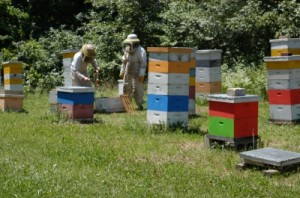 |
| Isn't this a pretty beeyard? Look at those sunny Langstroth hives. http://daily-survival.blogspot.com/2011/02/anatomy-of-honeybee-hive.html |
 |
| I love this TBH! http://www.themelissagarden.com |
 |
| Inside a TBH http://www.sustainlife.org/blog/tag/top-bar-hive/ |
| Langstroth (with foundationless frames) |
KTBH | Winner (for me anyway) |
|
|---|---|---|---|
| Bee Health | From what I've read, using commercial foundation in hives (which is what most people have), can make them more susceptible to varroa mites due to the large cell size. However, this would not be an issue with foundationless frames. Wax can be reused over and over, though, which may lead to an accumulation of toxins. | The natural cell size seems to help control varroa mites. Wax is harvested along with the honey so that bees constantly draw fresh wax that doesn't have a chance to accumulate toxins. From what I've heard, there are fewer reports of colony collapse disorder (CCD) as well. |
Almost a draw. But I give the KTBH the edge. |
| Disruption to hive | When you open a super, you basically open the whole hive at once. It seems very disruptive to suddenly change the temperature, lighting, etc. when they're nesting so cozily. Also, I'm not sure how keen I am on the idea of being faced with 60,000 bees all at once. |
One inspects a single bar at a time. The rest of the hive is kept closed. This seems a much less invasive approach to me. | KTBH |
| Maintenance | Actually, I'm not quite sure how often one has to check on the hive, but for some reason, I'm thinking it's a minimum of every two or three weeks. | I understand that bees prefer to build their nest downward, like in a Warre hive. It takes more work to coax them to build horizontally. I think checks are recommended every 7-10 days. | Langstroth |
| Weight | Each super (those boxes you see) on a Langstroth hive contains 8 or 10 frames. Depending on the size of the frames and how much honey is in them, the boxes can get really heavy. (48-90lbs!) | One handles only one bar of comb at a time. So one might have to pick up about 7 or 8 lbs at the most at a time. *Bonus* The hive can be mounted to any height I like, so no bending. |
I'm short and don't want back problems. Plus, I have slight arthritis in my hands. I don't need to chance dropping a box of bees. KTBH |
| Neighbors | I don't know why, but some people are really touchy about having thousands of stinging insects living next door or down the street. ;-) I think Langs are easily recognized and might make some people uneasy. | I think fewer passersby would recognize KTBHs. When finished, I'm hoping mine could easily pass for a birdhouse or garden object. | KTBH |
| Storage | It seems like one needs a lot of space to store equipment that isn't being used at the time, e.g., supers, frames, honey extractors, etc. | There isn't really much to store. All the bars remain on the hive. Most people I've seen keep a knife under the hive roof to separate bars. | KTBH |
| Messiness and comb strength | A Lang with foundationless frames is still a Lang. Langs are widely used for a reason. They're efficient, the comb stays where it's supposed to be and doesn't break off the frame, and burr comb and whatnot is easily scraped off. | Top bars require a gentle touch, especially with new comb. One has to be careful not to break the comb off the bar through mishandling or over haste. If the weather is too hot, combs can melt and collapse because they don't have frames to support them. |
Langstroth (though learning to be gentle and careful with bees confer its own benefits) |
| Wax Production | I guess with foundationless frames, one could harvest the was just like with a KTBH. But this type of hive also gives you flexibility to reuse the wax. | Wax is harvested along with the honey. Was production is probably equal to a Lang with foundationless frames. Definitely more than a Lang that uses foundation. | I want wax for candles and lotion and other uses. This is really close, but I'll say Langstroth because of the added flexibility. |
| Honey production | One has the ability to expand the size of the hive to any size one wants. This means more space for bees and honey. Reusing comb also helps bees make more honey. |
Because the hive size is not expandable, I've read that TBHs may produce up to 20% less honey. However, the mindset of most TBH keepers seems to be that honey is a secondary goal to bee health and well-being. Certainly, that's true for me. This is just a hobby, and I don't have to squeeze a profit out of my bees. |
Langstroth |
| Honey Extraction | Crush and strain method can be used, but it seems like most people who use Langs like honey extractors. Extractors are basically centrifuges that spin the honey out of two or more combs at once. They allow combs to be reused. |
Uses crush and strain method, though I've seen video of people modifying extractors to accommodate bars. It most people only harvest if the hive is getting too full, and then they take only a bar or two at a time -- just enough to give the bees room and suppress swarming. |
Reusing wax increases honey production. However, I read that bees take on different jobs over the course of their lives, so no matter what, there will always be bees drawing comb. Draw. |
| Cost | The packages I've seen run on average about $150 for a hive with baseboard, covers, two supers, frames, and some foundation. I wouldn't need foundation, but I'd still have to buy additional supers and frames all the time to expand the hive and replace broken parts. I'd also have to invest in harvesting & extracting equipment like capping scratchers, uncapping knives, extractors, etc. Oh, and I've mentioned that I'd have to find a place to keep all this stuff, too. |
Designed for third-world countries, these hives are cheap. I've heard of people getting free pallets (with untreated wood) and building TBH's for under $5. If you buy one, though, they seem much costlier than Langs -- probably because you never have to buy anything else. (I call this the Swiffer Scam. The mop itself is cheap, but then you're locked into buying the stuff that goes with it, so you pay more in the long run.) Harvesting just requires a bucket with honey gate, strainer, and potato masher. I can make a wax melter with a styrofoam box, plexiglass, and a duct tape. Very low tech. | I did not see any TBHs online that had all the features I wanted, but I've got an ace in the hole. I'm lucky to have married a woodworker, so he's building them to my specs, which include observation windows with safety glass. We purchased wood from a local lumberyard. With the wood, glass, and screen, we'll come out to about $80 per hive. If we weren't doing the windows, we'd probably cut the cost in half. KTBH |
| Standardization | No matter where you go, these are built to standardized dimensions, so it's easy to buy nucs or swap between hives. | There is no standard for these hives. Although most of the ones I've seen are a wooden box of some kind, some people weave them out of various materials or cobble them out of 55-gallon drums sawed in half. This makes it hard to swap equipment, so one usually has to order a package of bees or catch a swarm. |
Happily for me, my husband is making mine and can make all the dimensions of my equipment will be standard for me. But the Langstroth wins this round. |
I don't know how I'll feel at the end of the summer. Maybe I'll change my mind and get some Langs, but for now, the KBTH seem a better fit for my personality. (Basically, they won me over with less lifting.) So my DH has been busily working on them for the past month. I'm hopeful that they'll be assembled (fingers crossed) by next weekend. Stay tuned for photos.

